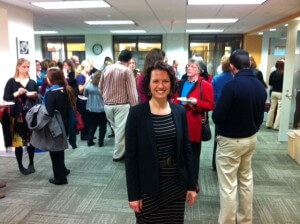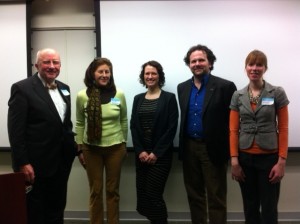
Look at all those people who came to hear me! Washington Conservation Guild meeting, February 7, 2013.
On Thursday, February 7, I was invited to speak to the Washington Conservation Guild about the state of collection care. Regular readers will know that this is a topic about which I’m passionate. Preventive care maintains our tangible heritage. End story. If you wait for damage to occur, the most skilled conservation treatment can never fully restore the break, the crease, the loss in original pigment.
My talk had attracted a lot of other passionate people, or at least the curious. Seventy-six people turned out at the George Washington University Museum Studies program offices for the event. While not wanting to toot my own horn, I consider this invitation, for a collection manager to speak about collection care, is a seminal moment for preservation. Conservators and foundations like Heritage Preservation have been supporting a preventive approach since the late 1970s. With the kick off of the AIC Collection Care Network in early 2012, it’s been a big year for maturation of collection care.
The main point of my talk was this: collection care isn’t a la carte.
We get caught up talking about the activities of collection care: I vacuum, I do IPM, I oversee the storeroom, I work with visitors to the collection, I manage the documentation for the collection. Instead, we need to talk about the why of collection care up front: I facilitate preservation and access through preservation of physical and intellectual aspects of collections.
The accomplishment of some piecemeal collection care activities is not a comprehensive collection care program, where the inputs can be measured and the outcomes assessed, to see if we need more or less resources. Right now, I would imagine most people think they accomplish collection care if they vacuum once a month, build some storage supports here and there for objects that look really bad, and check the sticky traps occasionally during the morning walkthrough.
We can do better, and these were my recommendations:
1) We need to better define collection care – among ourselves, for our administration, and for our audience.
2) We need to better support collection care practitioners – through mentoring, mid-career training, and advancement opportunities.
3) We need to develop collection care resources that increase skill and nurture collaboration between all museum professionals.
4) We need to get the public involved – we need to demonstrate to our administration that the public is interested in collection care and will support it if asked.
Thank you Washington Conservation Guild for giving me the opportunity to voice these ideas. I noted that preservation takes place over hundreds and thousands of years. So must our diligence in demonstrating our belief and commitment to preventive care.

